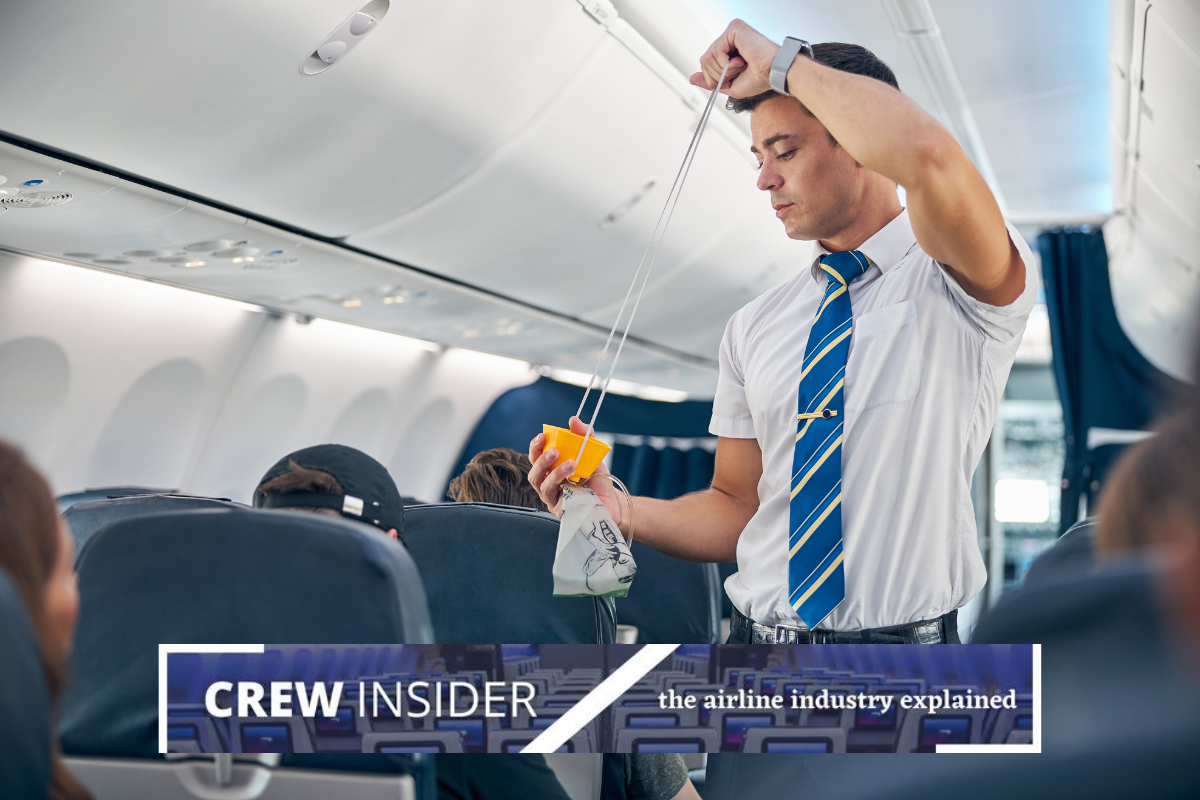
Crew Insider is our series of informative articles that answer some of the most common and less common questions about the aviation industry from the point of view of an industry insider. Our question answerer-in-chief is Mateusz Maszczynski, who has worked in the airline industry for nearly two decades and has honed his expertise in the field through this blog since 2015.
In this article, I wanted to address an interesting question that was recently filed on a flight attendant page of Reddit. It went like this: “If you’re in the lavatory and the oxygen masks deploy, how long should you stay in there? Do you wait for the all-clear or take a big breath and make a run for your seat?”
This seemed like a pretty interesting question because, I feel like most airline passengers are fairly well versed in what to do if the oxygen masks drop while they are in the assigned seat but there’s uncertainty about what to do if you happen to be out of your seat.
Certainly, airline safety demonstrations and safety cards make it clear to put your mask on first and then help others but this information always seems to assume that passengers are already in their seats when the oxygen masks drop.
So, what should you do if you’re in the lavatory or even standing in the aisle or the galley when the oxygen masks suddenly and unexpectedly drop?
To answer this question, the first thing to do is to cover some background about the pressurisation of an aircraft. The typical cruising altitude of a commercial airliner can be as high as 34,000 feet and at this height you would quickly lose consciousness if the cabin wasn’t pressurized.
The cabin of a commercial jet is generally pressurized to an altitude equivalent to 8,000 feet, but should this level start to rise (perhaps due to a faulty pressurization system or a leaky door seal), then there will first be warning signs that the oxygen masks are about to drop.
Once the aircraft pressure reaches between 10,000 feet and 11,000 feet, most airliners will start displaying warning signs. These can vary from manufacturer and aircraft model but include:
- The cabin lights automatically illuminate fully bright
- The seat belt signs automatically switch on
- The exit signs may also illuminate
At this point, the pilots will be trying to control the pressurization of the cabin to stop the situation from developing but if this isn’t possible and pressure reaches around 14,000 feet then the oxygen masks are going to automatically deploy.
Of course, there are also oxygen masks in the lavatories – generally more than one because parents often accompany their children into the restroom.
What you’ll notice, however, is that the ‘return to seat’ light in the lavatory does not illuminate in the event of the oxygen masks. Admittedly, it’s a pretty subtle message, but it’s trying to tell the occupant to stay put.
What you should expect is for the pilots to make a rapid descent to a safe altitude where the cabin air can be breathed without the risk of suffering from hypoxia, so you don’t want to be moving around the cabin.
Instead, sit on the toilet, fit the oxygen mask over your mouth and nose and hold onto something to steady yourself. There are lots of aircraft that have grab rails installed but gripping onto the basin is also the option.
The risk of leaving the lavatory isn’t, however, just because the aircraft is about to make a rapid descent. Removing the oxygen for even a very short amount of time could allow hypoxia to set in.
You might not lose consciousness straight away, but hypoxia could make you lose coordination and your perception or risk if could delay you getting to your assigned seat and putting on your oxygen mask.
Once the pilots have completed their rapid descent to a safe altitude, they’ll let the flight attendants know that it is safe for them to move about the cabin. At this point, you should stay put. The flight attendants will be checking on the welfare throughout the cabin and one of their assigned tasks is to check the occupants of the lavatories.
Even then, you might be asked to stay in the lavatory until the pilots give the all-clear, and everyone is allowed to remove their oxygen masks.
How long the oxygen lasts will depend on the aircraft type. Some single-aisle aircraft that only operate short-haul flights are fitted with oxygen systems that last just 15 minutes because it shouldn’t take any longer than that to reach a safe altitude.
Widebody aircraft, however, can have oxygen systems that last for up to an hour because if they are flying over a mountainous region, it will take longer to descend to a safe altitude.
Related
Mateusz Maszczynski honed his skills as an international flight attendant at the most prominent airline in the Middle East and has been flying ever since... most recently for a well known European airline. Matt is passionate about the aviation industry and has become an expert in passenger experience and human-centric stories. Always keeping an ear close to the ground, Matt's industry insights, analysis and news coverage is frequently relied upon by some of the biggest names in journalism.








That was a very interesting information. Honestly, I had not really thought about this situation.
Another question came to mind: what is the suggested procedure when you are in the lavatory and sudden turbulence occurs. Generally I think you should return to your assigned seat as quickly as possible. However, if some of the extreme turbulence occurs ( like on SQ or BR in recent months), I would assume it’s also safer to hold on to something in the restroom rather than trying to get to your assigned seat – even though it of course has seatbelts. What is your professional opinion?